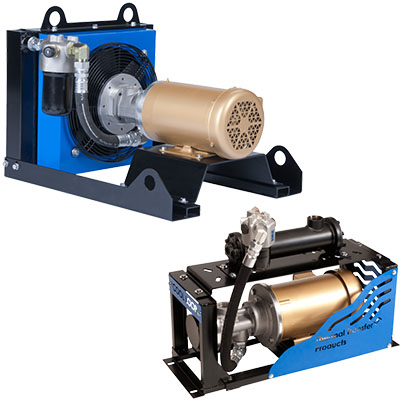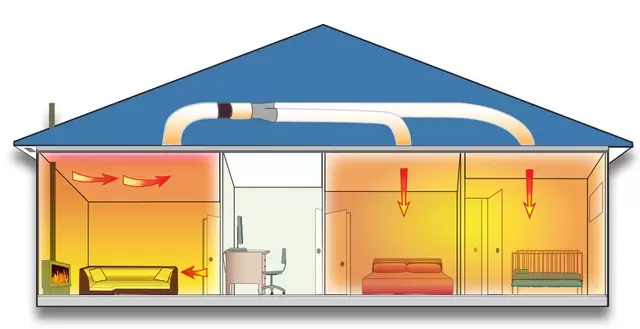What Makes DVS Heat Transfer Systems Ideal for Aerospace Thermal Solutions?
Wiki Article
Checking out the Benefits and Applications of Heat Transfer Solutions in Modern Market
Heat transfer systems play a necessary duty in modern-day market. They encompass various systems such as convection, conduction, and radiation, each contributing to reliable thermal monitoring. Industries like manufacturing and aerospace benefit significantly from these systems. As advancements continue, the combination of ingenious materials and modern technologies guarantees to improve power efficiency. This development elevates crucial concerns about the future implications for sustainability and operational costs across several industries. What lies in advance in this ongoing makeover?Comprehending Heat Transfer Concepts
Heat transfer concepts are basic to the procedure of various commercial systems. These concepts incorporate the mechanisms of conduction, radiation, and convection, each playing an essential function in managing thermal energy. Understanding conduction includes examining how Heat relocates via strong materials, while convection pertains to Heat transfer in liquids, driven by liquid motion. Radiation, unique from the various other 2, involves power transfer through electro-magnetic waves. The performance of Heat transfer impacts system performance, energy usage, and total productivity. Effective thermal management is essential in procedures such as air conditioning, home heating, and Heat recovery. By mastering these concepts, industries can maximize their procedures, decrease power costs, and improve devices durability, thereby adding to a more sustainable and efficient industrial landscape.Trick Sorts Of Heat Transfer Solutions
While different sectors utilize Heat transfer systems for diverse applications, a number of vital types stick out because of their certain functions and efficiencies. One of the most common types consist of radiation, conduction, and convection systems. Transmission systems transfer Heat with straight get in touch with between products, making them reliable in solid-state applications. Convection systems, on the various other hand, make use of liquid activity to move Heat, ideal for home heating or cooling gases and liquids. Radiation systems operate without a medium, depending on electro-magnetic waves to move Heat, perfect for high-temperature settings. Each kind offers distinctive objectives, permitting markets to customize their Heat transfer services based on operational requirements, energy efficiency, and cost-effectiveness. Understanding these systems is necessary for maximizing performance in various industrial settings.Industrial Applications of Heat Transfer Technologies
The application of Heat transfer innovations in industry plays a vital role in enhancing power effectiveness and enhancing processes. DVS Heat Transfer Systems. By implementing innovative Heat exchange systems, companies can significantly reduce their ecological effect while boosting general productivity. This integration not just fosters sustainability yet likewise aligns with modern-day regulative and consumer needs for greener methodsEnergy Performance Improvements
As industries significantly prioritize sustainability, power effectiveness improvements in Heat transfer technologies have actually become crucial for minimizing operational expenses and environmental effect. Enhanced Heat exchangers, for example, use innovative materials and styles to make best use of thermal performance while decreasing energy usage. Incorporating variable rate drives in pumping systems permits for better control of fluid circulation, leading to considerable power financial savings. The execution of smart sensors and automation supplies real-time surveillance, enabling modifications that maximize energy use. Additionally, waste Heat healing systems record excess thermal power, transforming it into functional power. These innovations not just improve energy efficiency but likewise add to a much more lasting commercial landscape by decreasing greenhouse gas emissions and supporting compliance with environmental regulations.Process Optimization Techniques
Process optimization techniques are important in boosting the performance and performance of Heat transfer innovations in industrial applications. These methods include refining processes to optimize Heat transfer efficiency while lessening energy usage and operational costs. Techniques such as computational fluid dynamics (CFD) modeling permit designers to examine and mimic Heat transfer circumstances, recognizing locations for enhancement. Additionally, real-time monitoring systems can give beneficial data on temperature slopes and circulation rates, enabling changes that enhance performance. In addition, applying sophisticated control strategies, such as anticipating analytics, can improve system responsiveness to varying functional demands. By applying these optimization techniques, markets can achieve higher thermal efficiency, minimized downtime, and improved item quality, inevitably resulting in raised competitiveness in the industry.
Environmental Influence Reduction
While commercial Heat transfer innovations are crucial for operational performance, their application also provides possibilities for significant ecological influence reduction. By enhancing power efficiency, these systems lessen gas consumption, resulting in reduced greenhouse gas exhausts. Advanced Heat exchangers can recoup waste Heat, redirecting it to preheat incoming fluids, thus minimizing power requirements. On top of that, the integration of Heat transfer technologies in renewable resource systems, such as solar thermal and geothermal applications, sustains the change to lasting methods. Industries that use these technologies also gain from decreased operational costs and enhanced regulative compliance. In general, the critical application of Heat transfer systems not just bolsters performance yet additionally promotes a much more sustainable industrial landscape, adding to global environmental objectives.Benefits of Effective Heat Transfer Systems
Efficient Heat transfer systems supply substantial benefits in contemporary industry, primarily via boosted power effectiveness and cost decrease. By maximizing thermal administration, these systems decrease power waste, causing lower functional prices (DVS Heat Transfer Systems). Services can achieve better sustainability and enhanced profitability.
Energy Performance Improvements
As markets progressively prioritize sustainability and cost-effectiveness, energy performance renovations in Heat transfer systems have arised as a critical emphasis. Improved effectiveness in these systems results in reduced energy intake, allowing facilities to run even more sustainably. By optimizing Heat transfer approaches, markets can reduce waste Heat and accomplish better thermal monitoring, considerably lowering their ecological impact. Developments in innovations such as Heat exchangers and insulation materials add to enhanced efficiency and dependability. Applying energy-efficient Heat transfer services not only sustains compliance with regulative criteria but additionally fosters a society of innovation within organizations. Inevitably, these improvements are necessary in aligning industrial procedures with international power conservation goals, leading the means for a more sustainable future in production and handling sectors.Cost Reduction Opportunities
By optimizing Heat transfer systems, markets can disclose significant expense reduction possibilities that boost their lower line. Efficient Heat transfer lowers power consumption, resulting in lower utility expenses and decreasing functional expenditures. Additionally, improved system efficiency lowers the demand for upkeep and repairs, additionally saving costs over time. Improved Heat transfer can likewise prolong devices life expectancy, enabling business to delay capital expenditures on replacements. Moreover, waste Heat healing systems can transform excess Heat into useful power, additionally driving down expenses. These systems not only improve processes yet additionally contribute to sustainability initiatives, placing firms favorably in a significantly eco-conscious market. Generally, the financial benefits of efficient Heat transfer systems are vital and substantial for affordable benefit.Developments in Heat Transfer Solutions
Just how can contemporary industry boost its operations through cutting-edge Heat transfer remedies? By embracing advanced products and technologies, sectors can considerably improve thermal performance and performance. Technologies such as nanofluids, which enhance Heat transfer capabilities past conventional liquids, and phase modification products that keep and launch thermal energy, are getting traction. Furthermore, the assimilation of smart DVS Heat Transfer Systems sensors and IoT tools enables real-time surveillance and optimization of Heat transfer processes, lowering waste and improving system responsiveness. In addition, additive manufacturing methods make it possible for the creation of even more complex Heat exchangers that maximize surface location while decreasing material usage. Jointly, these innovations drive operational performance and develop affordable advantages in various industries, consisting of production, aerospace, and power.The Duty of Heat Transfer in Sustainability Initiatives
While the promote sustainability proceeds to improve sectors, the duty of Heat transfer modern technologies comes to be significantly crucial in attaining ecological goals. Efficient Heat transfer systems facilitate energy efficiency by optimizing thermal monitoring in numerous procedures, significantly minimizing energy consumption and greenhouse gas emissions. For circumstances, advanced Heat exchangers are used in commercial applications to redeem waste Heat, therefore decreasing power waste. Furthermore, advancements such as phase change products improve thermal storage, adding to renewable power combination. The fostering of lasting fluids in Heat transfer systems can reduce ecological impact. By focusing on effective Heat transfer, markets not just enhance functional performance however also straighten with global sustainability campaigns, fostering a cleaner, extra sustainable future.Regularly Asked Questions
Exactly How Do Heat Transfer Solutions Influence Energy Prices in Manufacturing?
Heat transfer systems significantly affect energy expenses in production by boosting efficiency, minimizing waste, and optimizing thermal administration. These renovations lead to reduce functional expenses, eventually profiting total efficiency and profitability in industrial procedures.What Upkeep Is Needed for Heat Transfer Systems?
Maintenance for Heat transfer systems consists of normal inspections, cleansing of components, checking fluid degrees and problems, changing used components, and ensuring proper insulation. These actions improve efficiency, prolong life expectancy, and stop expensive breakdowns in procedure.Exist Safety And Security Interest In Heat Transfer Systems?
Safety and security worry about Heat transfer systems consist of prospective leaks, stress accumulation, and thermal risks. Correct style, routine upkeep, and adherence to security protocols are necessary to minimize these dangers and guarantee secure operation in commercial environments.
Just How Can I Pick the Right Heat Transfer System for My Business?
Selecting the right Heat transfer system involves examining factors such as performance, application requirements, budget plan constraints, and security requirements. A comprehensive evaluation of these elements will aid guarantee suitable performance and dependability in organization operations.What Prevail Failings in Heat Transfer Equipments and Their Reasons?

Comprehending transmission involves examining how Heat relocates through solid products, while convection pertains to Heat transfer in liquids, driven by fluid movement. By maximizing Heat transfer methods, markets can decrease waste Heat and achieve much better thermal monitoring, significantly decreasing their ecological impact. Waste Heat healing systems can change excess Heat right into usable energy, even more driving down expenses. Progressed Heat exchangers are made use of in industrial applications to reclaim waste Heat, consequently decreasing power waste. Common failures in Heat transfer systems include leaks, corrosion, and inefficient Heat exchange.
Report this wiki page